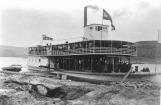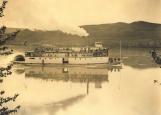8
When the Hudson's Bay Company decided to operate the S.S. Peace River on the upper Peace River beginning in 1905 they also decided to add a steam tug to their Peace River "fleet". The chosen vessel was the Messenger. It was used primarily for late seasons (August to October) runs from Fort Vermilion to as far away as Fort St. John in British Columbia.Design: the Messenger was a screw propeller design tug capable of carrying limited freight and passengers.
Builder: the Messenger was built in Kenora, Ontario in 1897 by an unknown builder for the Hudson's Bay Company.
Details: the Messenger was 33 feet long and 7 feet wide. It had a gross tonnage of 5 tons and a registered tonnage of 3 tons. The Messenger was the smallest steamboat to sail on the upper Peace River.
Ownership: the Messenger was owned by the Hudson's Bay Company from 1897 to 1914. It was apparently abandoned at Peace River Crossing in 1914.
Sources:
There is a detailed description of travel on the Messenger in Hulbert Footner's New Rivers of the North. Footner traveled on the boat with several passengers in 1911.
Note:
There were several vessels registered in Canada that went by the name of the Messenger (over 60), including at least one other steam tug used by the Hudson's Bay Company.
9
The Hudson's Bay Company tug Messenger at the Saint Henri Mission, Fort Vermilion.1911
Fort Vermilion, Alberta, Canada
 Credits:
Credits:University of Alberta Archives, Hulbert Footner Fonds, UAA 77-147-79
10
The Hudson's Bay Company steam tug, the Messenger, at Peace River Crossing.1911
Peace River Crossing, Alberta, Canada
 Credits:
Credits:University of Alberta Archives, Hulbert Footner Fonds, UAA 77-147-41
11
Passengers loading a reluctant cow onto the S.S. Grenfell.Circa 1912-4
Peace River Crossing, Alberta, Canada
 Credits:
Credits:Peace River Museum, Archives & Mackenzie Centre, 81.1194.089
12
Wood is being gathered as fuel for the S.S. Grenfell.Circa 1912-4
Peace River Crossing, Alberta, Canada
 Credits:
Credits:Peace River Museum, Archives & Mackenzie Centre, 81.1194.097
13
The S.S. Athabasca River was built by the Hudson's Bay Company at Athabasca Landing in 1912 and was subsequently moved to the Peace River in 1915. It was to steam on the Peace River through the 1919 season after which it was de-commissioned and turned into a warehouse at Peace River Crossing.Design: the S.S. Athabasca River was a stern-wheeler, designed and built by J.W. Mills for the Hudson's Bay Company.
Builder: J.W. Mills. Mills utilized two steam engines previously used by the S.S. Hazelton.
Details: the S.S. Athabasca River was 136 feet long and 28 feet wide. It had a gross tonnage of 340 tons and a registered tonnage of 230 tons. It employed two steam engines made by the Albion Iron Works previously used by the S.S. Hazelton.
Ownership: the S.S. Athabasca River was owned throughout its time on the Peace River by the Hudsons's Bay Company.
Sources:
Hudson's Bay Company Archives, Archives of Manitoba, A.12.Ft/341.1 'S.S. Athabasca River & Northern Transport, 1911-17'.
Note:
The S.S. Athabasca River which operated on the upper Peace River should not be confused with the S.S. Athabasca, launched on the Athabasca River in 1888 and the S.S. Athabasca River , built at Fort McMurray in 1922.
14
The S.S. Athabasca River at Peace River Crossing.9 May 1913
Peace River Crossing, Alberta, Canada
 Credits:
Credits:Peace River Museum, Archives & Mackenzie Centre, 75.622.024
15
The S.S. Athabasaca River.Circa 1914-1916
Athabasca River, Alberta, Canada
 Credits:
Credits:Peace River Museum, Archives & Mackenzie Centre, 76.689.006
16
The S.S. Northland Call.Circa 1916-1920
Athabasca River, Alberta, Canada
 Credits:
Credits:Peace River Museum, Archives & Mackenzie Centre, 76.689.007
17
The largest and most magnificient steamboat to be used on the upper Peace River was the S.S. D.A. Thomas. The latter was named after its owner D.A. Thomas (Lord Rhondda) and designed by George Askew. Launched from its building site in West Peace River in 1915 the D.A. Thomas was to operate on the upper Peace River until 1930.Design: the S.S. D.A. Thomas was designed to be a luxurious stern-wheeler by George Askew of Vancouver.
Builder: the S.S. D.A. Thomas was built in the winter of 1914-5 at the West Peace Boatyards by George Askew of Vancouver.
Details: the S.S. D.A. Thomas was 162 feet in length and 37 feet wide. It had a gross tonnage of 1,145 tons and a registered tonnage of 798 tons. It employed two Polson steam engines, generating 21.6 Nautical Horse Power.
Ownership:
1915-1920: built and owned by the Peace River Develpment Corporation (a company owned by Lord Rhondda)
1921-1924: owned and operated by the Alberta and Arctic Transportation Company (part of Lamson & Hubbard)
1924-1930: owned and operated by the Hudsons' Bay Company
18
The S.S. D.A. Thomas.Circa 1928-1930
Shaftesbury Trail, Alberta, Canada
 Credits:
Credits:Peace River Museum, Archives & Mackenzie Centre, 2008.056.002
19
The S.S. D.A. Thomas heading upriver from Peace River Crossing.circa 1916-1930
Peace River Crossing, Alberta, Canada
 Credits:
Credits:Peace River Museum, Archives & Mackenzie Centre, 72.453y
20
The S.S. D.A. Thomas (right) anchored next to the S.S. Peace River (left).circa 1916
Peace River Crossing, Alberta, Canada
 Credits:
Credits:Peace River Museum, Archives & Mackenzie Centre
21
Steamboats docked at Peace River Crossing.Circa 1918-1930
Peace River Crossing, Alberta, Canada
 Credits:
Credits:Peace River Museum, Archives & Mackenzie Centre, 2008.056.003